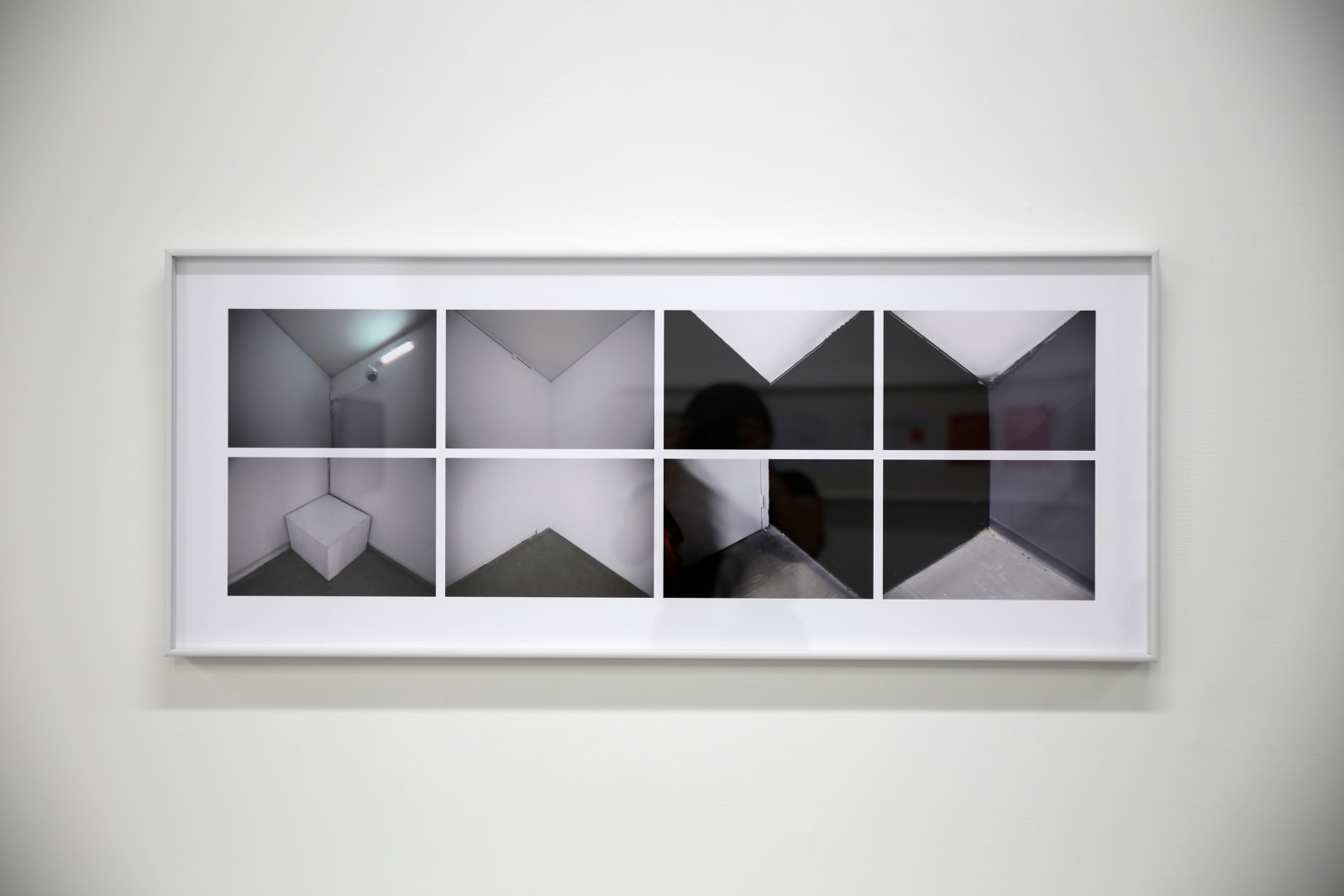 Images of the corner in Room 103 at Taipei Fine Arts Museum.
臺北市立美術館103室的角落影像
Images of the corner in Room 103 at Taipei Fine Arts Museum.
臺北市立美術館103室的角落影像
 Floor plan of “Taipei Biennial Exhibition Space for Auction”.
〈網拍台北雙年展空間〉平面圖
Floor plan of “Taipei Biennial Exhibition Space for Auction”.
〈網拍台北雙年展空間〉平面圖
 Installation view
展場照
Installation view
展場照
 Installation view
展場照
Installation view
展場照
 Installation view
展場照
Installation view
展場照
Shi Jin-Hua
21.4 x 27.8 cm (floor plan)
14.3 x 24.7 (text)
5′ 13″
Further images
Indexing the Moon, the production of
conceptual artist Shi Jin Hua, is the sequel of his 2010 Taipei Biennial
participating piece, Taipei Biennial Exhibition Space Auction,
which allowed participants to
organize exhibition once they got the bid. Located on the ground floor of Taipei
Fine Arts Museum, the exhibition space was hold by
the bidder for three consecutive shows during the Biennial time. The whole
process, including the very space itself, was claimed by the artist as a piece
of art work and presented in Indexing the
Moon, borrowed from the title of a 17th Zen classic in
referencing to the
unsayable wisdom. Shi has fabricated a
paradoxical situation for a possible collection, which is located in the actual museum space and can be archived by
the museum itself. Shi
is always interesting in creating highly conceptual work to show
the axiomatic relation of art found in everyday life and to render it
politicality, mainly because the cultural production itself can determine our
social relation and can regulate our inner perception of art.
collected from the outside of a museum, but from the within. The piece constantly defines the boundary of what we can recognize as artwork
through reconfiguring the topology of the exhibition, much in line of
Smithson’s notions of the site and non-site. Shi gives it a contemporary touch
and broaden these issues, including the outsourcing performativity, the social
matrix of cultural production, and the mechanism of exhibition. Most
importantly, the work prompts us to ask who can actually own the exhibition
space and the arts as well. Shi has offered a cultural production is nothing
but the circulation, consumption, and accumulation of various arts in the
field, where different positions and trajectories are taken and projected.
Especially for the ideology of the white cube, every show has to make it new,
and the old one is doomed to be forgotten—the contemporary spectator are
trained to have the exhibition amnesia.
石晉華〈指月錄〉延續2010年臺北雙年展〈網拍台北雙年展空間〉計劃,藉由藝術在文化場中的生產狀態,於其中,不斷將生產的流通、累積、製造、及消費等關係,作為一個透明化的開示。換言之,是一個自明(axiomatic)關係的文化政治詮釋行動,正因為這種生產關係同時也界定了其社會關係。石將當時位於臺北市立美術館一樓103室的部分空間拍賣,將所得作為製作作品的材料費,而位於103室的空間成為拍賣所得人的佈置展間,這之間的過程、行為及物質基礎的「作品化」是〈指月錄〉的主要基調。美術館的物理空間是作品發生的場域,作品不能脫離其空間而獨立存在成為「自為之物」(autonomous object)。103室是作品發生的原初場景,而這件作品界限原本就在美術館本身的空間,因此造成一種詭譎的典藏行為,因為典藏品再也不是從美術館「外部」來的物件,而是美術館自身。這個發生在「似非而是」的吊詭性,捲入這個猶如禪宗公案般的作品,如何典藏「不可典藏」的作品。權借明代瞿汝稷編纂禪宗言行的「水月齋指月錄」書名, 說明文字如指,禪機如月的開悟。不斷界定藝術作品的界限、邊緣及其拓樸關係,包含著作品的委外(outsourcing)的表演性,各個複雜運作在文化場域的社會關係、以及作品過程所牽涉的展覽機制等等。而更為重要的是,而其歸屬為何?誰擁有這個作品及展示空間?又如何作為作品進行典藏?藉由〈指月錄〉的發表及其見所包含的過程性,石晉華讓展演關係作為生產的呈現。而在當代展演中,美術館、藝術家、策展人及觀眾已成為消費環節的一部分,在每檔「除舊佈新」的展演邏輯中,展場是一個不斷被遺忘的場域,在美術館、畫廊的空間中,我們早已學會了白盒子的「健忘症」。同時讓曾經「在場」的作品的重回現場,在發生作品展覽過的場所徊返其發生的空間作為收藏、展示及創作的歷程,在一種自我反觀(reflexive)的過程展現自身。
◆〈指月錄〉2013|數位輸出、單頻道錄像(有聲、彩色)|角落影像:43 x 105 cm,平面圖:21.4 x 27.8 cm,文字: 14.3 x 24.7,5′ 13″
Exhibitions
2013 “Indexing the Moon”, Mind Set Art Center, Taipei, Taiwan
2013「指月錄」,安卓藝術,台北,台灣






